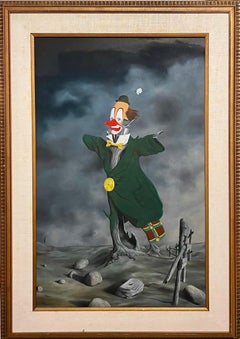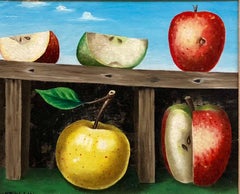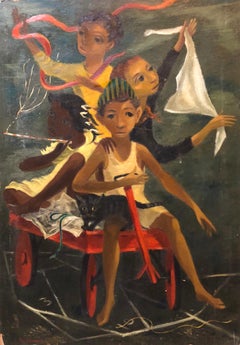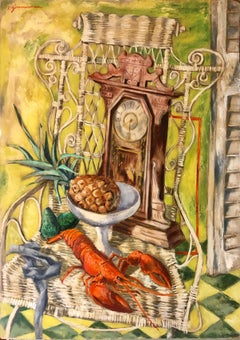Want more images or videos?
Request additional images or videos from the seller
1 of 13
Alberto TrevisanLarge Italian Surrealism Painting Colorful Scarecrow Clown, Surrealist Landscapec.1950's
c.1950's
$1,200List Price
About the Item
- Creator:Alberto Trevisan (Italian)
- Creation Year:c.1950's
- Dimensions:Height: 40 in (101.6 cm)Width: 28 in (71.12 cm)
- Medium:
- Movement & Style:
- Period:
- Condition:good. minor wear.
- Gallery Location:Surfside, FL
- Reference Number:1stDibs: LU38210115812
About the Seller
4.9
Platinum Seller
Premium sellers with a 4.7+ rating and 24-hour response times
Established in 1995
1stDibs seller since 2014
1,810 sales on 1stDibs
Typical response time: 1 hour
Authenticity Guarantee
In the unlikely event there’s an issue with an item’s authenticity, contact us within 1 year for a full refund. DetailsMoney-Back Guarantee
If your item is not as described, is damaged in transit, or does not arrive, contact us within 7 days for a full refund. Details24-Hour Cancellation
You have a 24-hour grace period in which to reconsider your purchase, with no questions asked.Vetted Professional Sellers
Our world-class sellers must adhere to strict standards for service and quality, maintaining the integrity of our listings.Price-Match Guarantee
If you find that a seller listed the same item for a lower price elsewhere, we’ll match it.Trusted Global Delivery
Our best-in-class carrier network provides specialized shipping options worldwide, including custom delivery.You May Also Like
Spring Garden
Located in Zofingen, AG
Spring Garden" landscape in the style of Paul Cezanne. Impressionism" original oil painting by Volskya Lilya
Magical iridescence of colors on canvas.
For...
Category
2010s Surrealist Still-life Paintings
Materials
Canvas, Cotton Canvas, Cardboard
Charles Houghton Howard Surrealist Painting Still Life with Hand and and Egg
By Charles Houghton Howard
Located in Brookville, NY
California artist Charles Houghton Howards Surrealist painting of a hand holding a green egg was painted in 1931.
He was represented by the legendar...
Category
Mid-20th Century Surrealist Still-life Paintings
Materials
Oil
Still life with peppers - Figurative Oil Painting, Realism, Polish art
By Zbigniew Wozniak
Located in Warsaw, PL
ZBIGNIEW WOZNIAK (b. 1952)
Studied at the Academy of Fine Arts in Wroclaw, at the Department of Glass and Ceramics. He is involved in painting, graphics and artistic glass design. He...
Category
Early 2000s Surrealist Figurative Paintings
Materials
Canvas, Oil
$300
H 9.45 in W 11.82 in
Still life with pumpkin - Figurative Oil Painting, Realism, Polish art
By Zbigniew Wozniak
Located in Warsaw, PL
ZBIGNIEW WOZNIAK (b. 1952)
Studied at the Academy of Fine Arts in Wroclaw, at the Department of Glass and Ceramics. He is involved in painting, graphics and artistic glass design. He...
Category
2010s Surrealist Figurative Paintings
Materials
Oil, Canvas
$601
H 10.63 in W 16.15 in
"Light and Noise, " Oil Painting
By David Cheifetz
Located in Denver, CO
David Cheifetz's "Light and Noise" is an original, handmade oil painting that depicts a monochromatic human ear with a wire above a lightbulb with various kettles ascending on the ri...
Category
2010s Surrealist Figurative Paintings
Materials
Oil
"While You Weren't Looking" by David Cheifetz, Oil on Aluminum Panel Painting
By David Cheifetz
Located in Denver, CO
David Cheifetz's "While You Weren't Looking" (2025) is an original, handmade oil painting on aluminum panel that depicts a lush still-life featuring a bright yellow pitcher, red onio...
Category
2010s Surrealist Still-life Paintings
Materials
Oil, Panel
"Melon" by David Cheifetz, Oil on Aluminum Panel Painting
By David Cheifetz
Located in Denver, CO
David Cheifetz's "Melon" (2025) is an original, handmade oil painting on aluminum panel that depicts a lush still-life featuring a brightly lit watermelon, apple and assorted fruits,...
Category
2010s Surrealist Still-life Paintings
Materials
Oil, Panel
"Hemerocallis I" (2022) by Sybiline, Oil Painting, Pink Day Lily
Located in Denver, CO
Sybiline's (CAN based) "Hemerocallis I" is an original, handmade oil painting that depicts a portrait of a pink day lily.
About the Artist:
Sybiline is a Canadian artist based in Q...
Category
2010s Surrealist Figurative Paintings
Materials
Oil, Panel
"Hemerocallis III" (2022) by Sybiline, Oil Painting, Pink & White Day Lily
Located in Denver, CO
Sybiline's (CAN based) "Hemerocallis III" is an original, handmade oil painting that depicts a portrait of a pink and white day lily.
About the Artist:
Sybiline is a Canadian artis...
Category
2010s Surrealist Figurative Paintings
Materials
Oil, Panel
"Hemerocallis II" (2022) by Sybiline, Oil Painting, Pink Day Lily
Located in Denver, CO
Sybiline's (CAN based) "Hemerocallis I" is an original, handmade oil painting that depicts a portrait of a pink day lily.
About the Artist:
Sybiline is a Canadian artist based in Q...
Category
2010s Surrealist Figurative Paintings
Materials
Oil, Panel
More From This Seller
View AllLarge Italian Surrealism Painting Colorful Scarecrow Clown, Surrealist Landscape
Located in Surfside, FL
Framed 40 X 28 sight 32 X 20.5 inches.
Bears his address verso Via Innocenzo n.57 Roma. (Rome, Italy
Titled: L'Ultimo "Clown"
Hand signed lower left and bears artists name verso.
...
Category
Mid-20th Century Surrealist Figurative Paintings
Materials
Paint, Board
French Surrealist Trompe L'oeil Apples OIl Painting
By Lucien Mathelin
Located in Surfside, FL
size uncludes frame.
Lucien Mathelin, born in 1905 in Binche, A province of Hainaut, in Wallonia, Belgium, and died in 1981 in Paris. French painter. His work was influenced by surrealism andtinged with irony.
Lucien Mathelin was born in a family of artists and has benefited from artistic training since childhood. He made his first oil on canvas at the age of 15 in 1920. In 1924, he exhibited at the Salon d'Automne which he became a member. He did not study plastic arts, but traveled to Morocco (1925-1926) and Greece (1933-1934), where he enriched his palette. In 1937, Mathelin worked for a while for Raoul Dufy to realize the gigantic painting...
Category
20th Century Surrealist Still-life Paintings
Materials
Canvas, Oil
Modernist Oil Painting Social Realist Kids and Cat in Red Wagon WPA Style
By Paul Zimmerman
Located in Surfside, FL
Oil on artist's board, 20th century, signed Paul Zimmerman Reminiscent of the Mid Century Social Realist and WPA works of Ben Shahn this captures a group of tenement children of mixe...
Category
Mid-20th Century American Realist Figurative Paintings
Materials
Oil, Board
Modernist Oil Painting Still Life Tableaux with Lobster, Pineapple and Clock
By Paul Zimmerman
Located in Surfside, FL
Oil on artist's board, 20th century, signed P. Zimmerman Reminiscent of the Mid Century Social Realist and WPA works of Ben Shahn this captures a still life table top kitchen scene. ...
Category
Mid-20th Century American Realist Figurative Paintings
Materials
Oil, Board
Large Trompe L'oeil Oil Painting Rene Chavelle Belgian Photo Realist Peppers
Located in Surfside, FL
Monumental Hyper Realist Still Life Painting Of Peppers,
Hand Signed
Oil on canvas
48 x 48 in, 58 x 58 in (framed)
Perfect for a ki...
Category
20th Century Pop Art Figurative Paintings
Materials
Canvas, Oil
Large Modernist Rose Bouquet Oil on Linen Painting Aaron Fink
By Aaron Fink
Located in Surfside, FL
"Rose Bouquet (Tenor) (2002)" by Aaron Fink (American, b. 1955)
Signed, titled, and dated verso.
Born in Boston, Fink received his BFA from the Maryland Institute College of Art and his MFA from the Yale University School of Art. His work has been exhibited widely throughout the U.S., Europe, Japan and Australia. He has been the subject of solo exhibitions at the Massachusetts Institute of Technology, the Muskegon Museum of Art, Michigan, the Rockford Art Museum, Illinois, and Colorado State University, Fort Collins.
In 2002 a monograph on Fink’s work, Out of the Ordinary, was published, with text by Eleanor Heartney. In 1983 Fink met the collector John Powers, who remained a strong supporter of his work until his death in 1999. Fink’s work is represented in the collections of the Art Institute of Chicago, the Hara Museum, Tokyo, the Metropolitan Museum of Art, New York, the Museum of Modern Art, New York and the National Gallery of Art, Washington, DC, among many others. Fink currently divides his time between Boston and Rockport, Massachusetts.
Selected Group Exhibitions
Contemporary Responses to Modernism: A New England Perspective, University of Southern Maine, Gorham, 2019, with Martha Armstrong, Ben Aronson, Gideon Bok, Sascha Braunig, Bernard Chaet, Susanna Coffey, Aaron Fink, Jon Imber, Dinorá Justice, David Kapp, György Kepes, Kayla Mohammadi, Jim Ritchie, Ann Weber
Color and Line: Expressive Tradition in Boston, Endicott College, Beverly, MA, 2017 Boston’s unique approach to Expressionism by uniting works from the late 1930s to the present day through an examination of subject, process, and materials. Influenced by the teachings of German Expressionist Karl Zerbe, and the early work of Hyman Bloom and Jack Levine.
Summertime 16: The Big Annual Group Show, Galerie Christoffer Egelund,
Copenhagen, Denmark, 2016
Beautiful Decay, Danforth Art Museum, Framingham, MA, 2016
MICA Then and Now, Ethan Cohen Gallery, Beacon, New York, 2013
Stuart Abarbanel, Donald Baechler, Brock Enright, Aaron Fink, Frank Hyder, Peter Greaves, Morris Louis, Herman Maril
The Expressive Voice, Danforth Museum, Framingham, MA, 2012
Bon Appetit, Concord Art Association (curated by Meredyth Hyatt Moses), 2010 Celebrating Ten Years, Galerie D’Avignon, Montreal, Canada, 2008
New England Impressions II: Exploring the Woodcut, Concord Art, Concord, MA, 2008 with artists: Doug Andersen, Leonard Baskin, Aaron Fink, Don Govett, Peik Larsen, Michael Mazur, Barry Moser, Brian Shure,
Heidi Siebel, Annie Silverman, Andrew Stevovitch, James Stroud.
Right to Print: Segura Publishing Company, Scottsdale Museum of Contemporary Art,
Go Figure: The Figure in Contemporary Art – A Response to Art History,
McIninch Art Gallery, Southern New Hampshire University, 2007
Fourteen Artists/Fourteen Years: Mahaffey Fine Art, Portland Art Museum,
Portland, OR, 2006-2007
More Than One: Prints and Portfolios from the Center Street Studio, Boston
Painting in Boston: 1950-2000, DeCordova Museum and Sculpture Park, Lincoln, MA, 2002
A Tribute to John Powers, Hatton Gallery, Colorado State University, Fort Collins, CO, 2000
A Salute to Boston, Wiggin Gallery, Boston Public Library, Boston, MA, 1998
Be Still Dear Art, New England School of Art and Design, Boston, MA, 1998
Attributes of the Artist, The Art Complex Museum, Duxbury, MA, 1997
Working Sources: The Painter and the Photographic Image, Alpha Gallery, Boston, MA, 1997
The Unique Print: Six Innovative Approaches to the Monotype, Starr Gallery, Newton, MA, 1997
Face and Figure, Museum of Fine Arts, Boston, MA, 1996
Grand Illusions: Four Centuries of Still Life Painting, Museum of Fine Arts, Boston, MA, 1994
The Label Show, Museum of Fine Arts, Boston, MA, 1994
Selections from Atelier Mourlot, Hankyu Department Store, Tokyo, Japan, 1993
Yale Collects Yale, Yale University Art Gallery, New Haven, CT, 1993
Includes works by Thomas Bang, Jennifer Bartlett, Jonathan Borofsky, Chuck Close, Steve Currie, Rackstraw Downes, Aaron Fink, Audrey Flack, Nancy Graves, Eva Hesse, Brice Marden, Claes Oldenburg, and more.
Fast Forward: Six Years of Collecting for a New Museum, Samuel P. Harn Museum of Art, Gainesville, FL, 1993
A Decade of Print Publishing, Neuberger Museum of Art, Purchase, NY, 1993
The Art Collection of the Federal Reserve Board: Five Years of Accessions, Board of Governors Building, Washington, DC, 1992
The Object: Found, Observed, Imagined, Fitchburg Art Museum, Fitchburg, MA, 1991
The Unique Print, Museum of Fine Arts, Boston, MA, 1990
8 Artists/8 Visions, DeCordova Museum, Lincoln, MA, 1990
The 1980s: Prints from the Collection of Joshua P. Smith, National Gallery of Art, Washington, DC, 1989-1990
The Age of Pluralism, Centro di Cultura Ausoni, Rome, Italy, 1989
Award Candidates Show, American Academy and Institute of Arts and Letters, New York, NY, 1987
70’s into 80’s: Printmaking Now, Museum of Fine Arts, Boston, MA
Skowhegan Alumni, Leo Castelli Gallery, New York, and Portland Museum of Art, Portland, Maine, 1986
Public and Private: American Prints Today, Brooklyn Museum, Brooklyn, NY, 1986
Highlights: Selections from the Bank of America Headquarters, San Francisco, CA, 1984
Local Visions IV: Portraits, Hayden Gallery, MIT, Cambridge, 1984
Contemporary Miami Collectors, Metropolitan Museum, Coral Gables, FL, 1984
The Modern Art of the Print: Selections from the Lois and Michael Torf Collection, Museum of Fine Arts, Boston, and Williams College Museum of Art, 1984
Painting and Sculpture Today, Indianapolis Museum of Art, 1984
The New Portrait, Institute of Art and Urban Resources, Project Studio One, Long Island City, New York, 1984
The American Artist as Printmaker, Brooklyn Museum, Brooklyn, NY, 1983-84
Boston Now: Part II, Institute of Contemporary Art, Boston, MA, 1983
Jon Abbot, Aaron Fink, Tom Lieber, Chris Wool, Delahunty Gallery, New York, NY, 1983
The Figure Beside Itself: Contemporary Figurative Prints, University of Massachusetts, Amherst, MA, 1982
Art of the State, Rose Art Museum, Brandeis University, Waltham, MA, 1982
Boston Now: Figuration, Institute of Contemporary Art, Boston, MA, 1982
A Private Vision: Contemporary Art from the Graham Gund Collection, Museum of Fine Arts, Boston, MA, 1982
Boston Printmakers 32nd National Exhibition, DeCordova Museum, Lincoln, MA, 1979-1980
Works on Paper from the Yale School of Art, Victorian College of the Arts Gallery, Melbourne, Australia, 1978
S E L E C T E D C O L L E C T I O N S
Art Institute of Chicago
Bank of America
Boston Public Library
Bouwfonds Nederlandse Gemeenten, The Netherlands
Brooklyn Museum of Art
Castelli Collection, New York
Chase Manhattan Bank
Chemical Bank
Children's Hospital, Chicago
Choate Rosemary Hall...
Category
Early 2000s Contemporary Figurative Paintings
Materials
Linen, Oil
Recently Viewed
View AllMore Ways To Browse
Mid Century Surrealism Art
Vintage Clown Sign
Mid Century Clown Painting
Large Clowns
Young Girl Oil Painting 20th Century
Wpa Artists
African American Folk Art Painting
Boulder Colorado
Oil Paintings Polish
Late 19th Century Spanish Painting
Peter Max Painting On Canvas
Saint Etienne
African Oil Paintings
Florida Artists Who Paint In Oil On Canvas
African American Artist Still Life
German Early 20th Century Expressionist Painting
The Young Painter
Young Female



